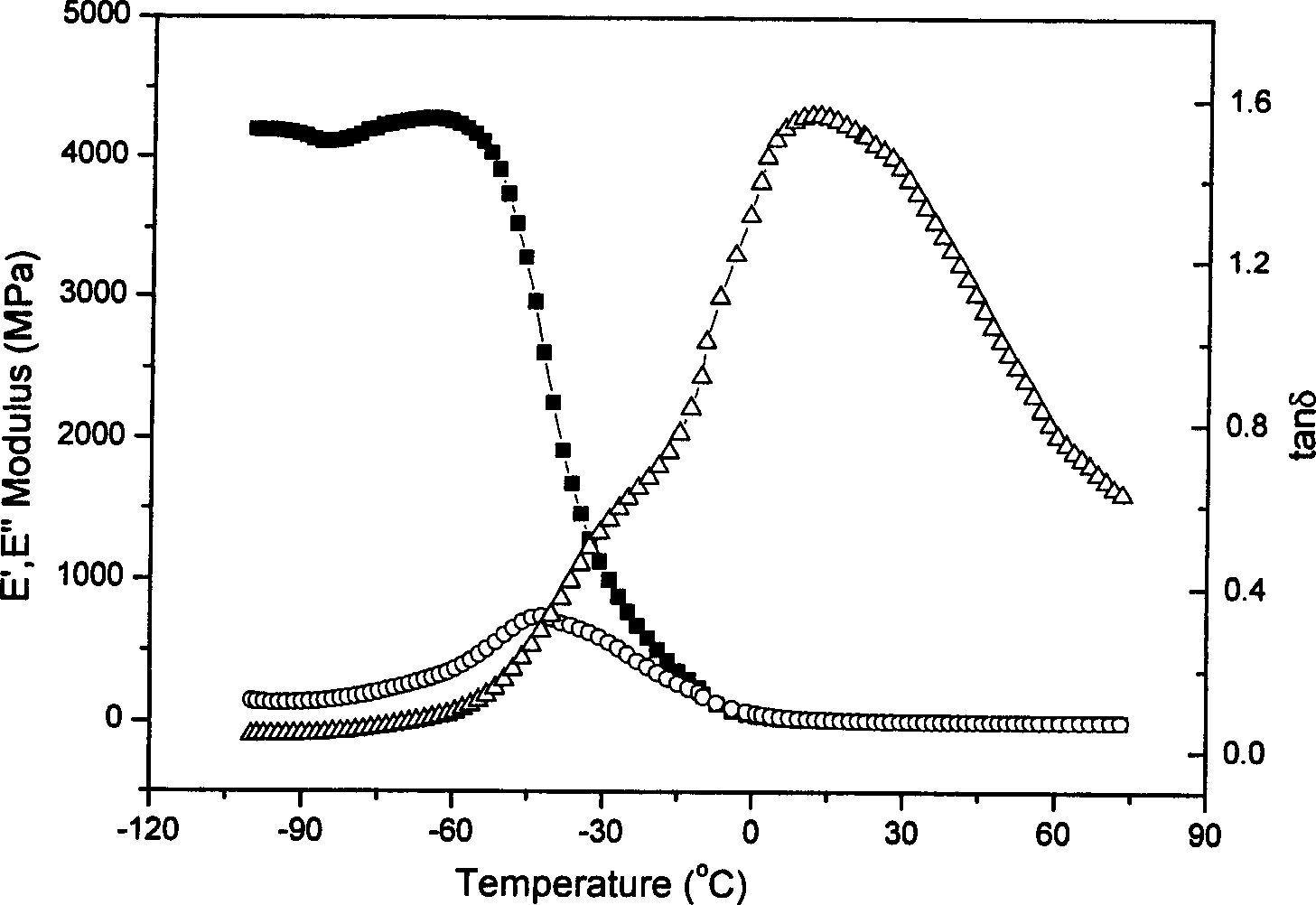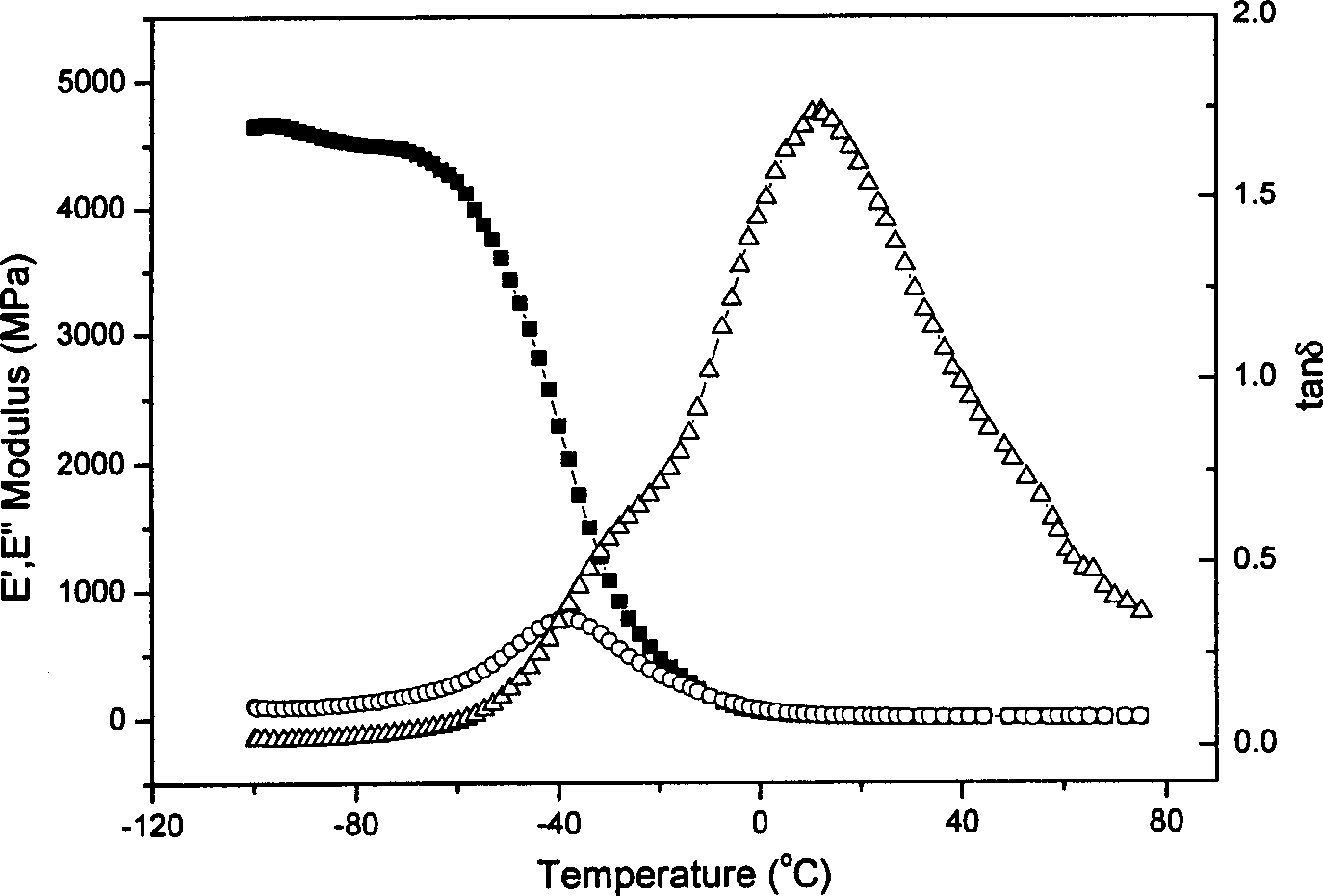Blend sulfurized compound damping material of butyl rubber/chlorinated polyethylene olefin and prepn. process
A technology of composite damping material and chlorinated polyolefin, which is applied in the field of polymer material molding and processing, can solve the problems of unsatisfactory damping performance improvement, reduced service life, and resistance to compression permanent deformation in service characteristics, and achieves good mechanical properties and improves damping. performance, the effect of increasing the damping value
- Summary
- Abstract
- Description
- Claims
- Application Information
AI Technical Summary
Problems solved by technology
Method used
Image
Examples
Embodiment 1
[0034] Example 1: Mix 100 grams of chlorinated butyl rubber and 30 grams of chlorinated polyethylene at a temperature of 160° C. on a double-roller rubber mixer for 20 minutes, then add 20 grams of phenolic resin and 5 grams of zinc oxide at 30° C. , 0.5 grams of magnesium oxide, 1 gram of stearic acid and 15 grams of chlorinated paraffin. After the rubber materials are mixed evenly, thin pass and make a triangle bag and a roll for 5 times each, adjust the roller distance to 2mm to output the film, and park it for 24 hours for use. The mixed rubber was molded on a flat vulcanizing machine at a temperature of 160°C and a pressure of 10 MPa for 15 minutes to prepare samples. Use dynamic mechanical test analyzer to characterize the dynamic mechanical properties of materials, such as figure 1 shown. The results show that the mechanical internal friction peak height of the material is 1.72, the temperature corresponding to the maximum loss factor is +16.5°C, and the temperature ...
Embodiment 2
[0035] Embodiment 2: 100 grams of chlorinated butyl rubber and 30 grams of chlorinated polyethylene were mixed for 20 minutes at room temperature on a double-roller rubber mixer, and then 20 grams of phenolic resin, 5 grams of zinc oxide, and phenolic resin were added at 40 ° C. 0.5 grams of magnesium oxide, 1 gram of stearic acid and 10 grams of chlorinated paraffin. After the rubber materials are mixed evenly, thin pass and make triangle bag and roll 5 times each, adjust the roller distance to 3mm to output the film, and park it for 24 hours for use. The mixed rubber was molded on a flat vulcanizing machine at a temperature of 170°C and a pressure of 8 MPa for 10 minutes to prepare samples. Use dynamic mechanical test analyzer to characterize the dynamic mechanical properties of materials, such as figure 2 shown. The results show that the mechanical internal friction peak height of the material is 1.56, the temperature corresponding to the maximum loss factor is +13°C, an...
Embodiment 3
[0036] Embodiment 3: 100 grams of chlorinated butyl rubber and 30 grams of mechanically degraded chlorinated polyethylene (that is, pulverized for 12 hours by a vibrating ball mill) were mixed for 5 minutes at a temperature of 140° C. on a double-roller rubber mixer, and then Add 20 grams of phenolic resin, 1.5 grams of zinc oxide and 5 grams of chlorinated paraffin at 60°C. After the rubber materials are mixed evenly, thin pass and make a triangle bag and a roll for 5 times each, adjust the roller distance to 2mm to output the film, and park it for 24 hours for use. The mixed rubber was molded on a flat vulcanizing machine at a temperature of 150°C and a pressure of 8 MPa for 15 minutes to prepare samples. Use dynamic mechanical test analyzer to characterize the dynamic mechanical properties of materials, such as image 3 shown. The results show that the mechanical internal friction peak height of the material is 1.74, the temperature corresponding to the maximum loss facto...
PUM
| Property | Measurement | Unit |
|---|---|---|
| Tensile strength | aaaaa | aaaaa |
| Tensile strength | aaaaa | aaaaa |
| Tensile strength | aaaaa | aaaaa |
Abstract
Description
Claims
Application Information
 Login to View More
Login to View More - R&D
- Intellectual Property
- Life Sciences
- Materials
- Tech Scout
- Unparalleled Data Quality
- Higher Quality Content
- 60% Fewer Hallucinations
Browse by: Latest US Patents, China's latest patents, Technical Efficacy Thesaurus, Application Domain, Technology Topic, Popular Technical Reports.
© 2025 PatSnap. All rights reserved.Legal|Privacy policy|Modern Slavery Act Transparency Statement|Sitemap|About US| Contact US: help@patsnap.com



